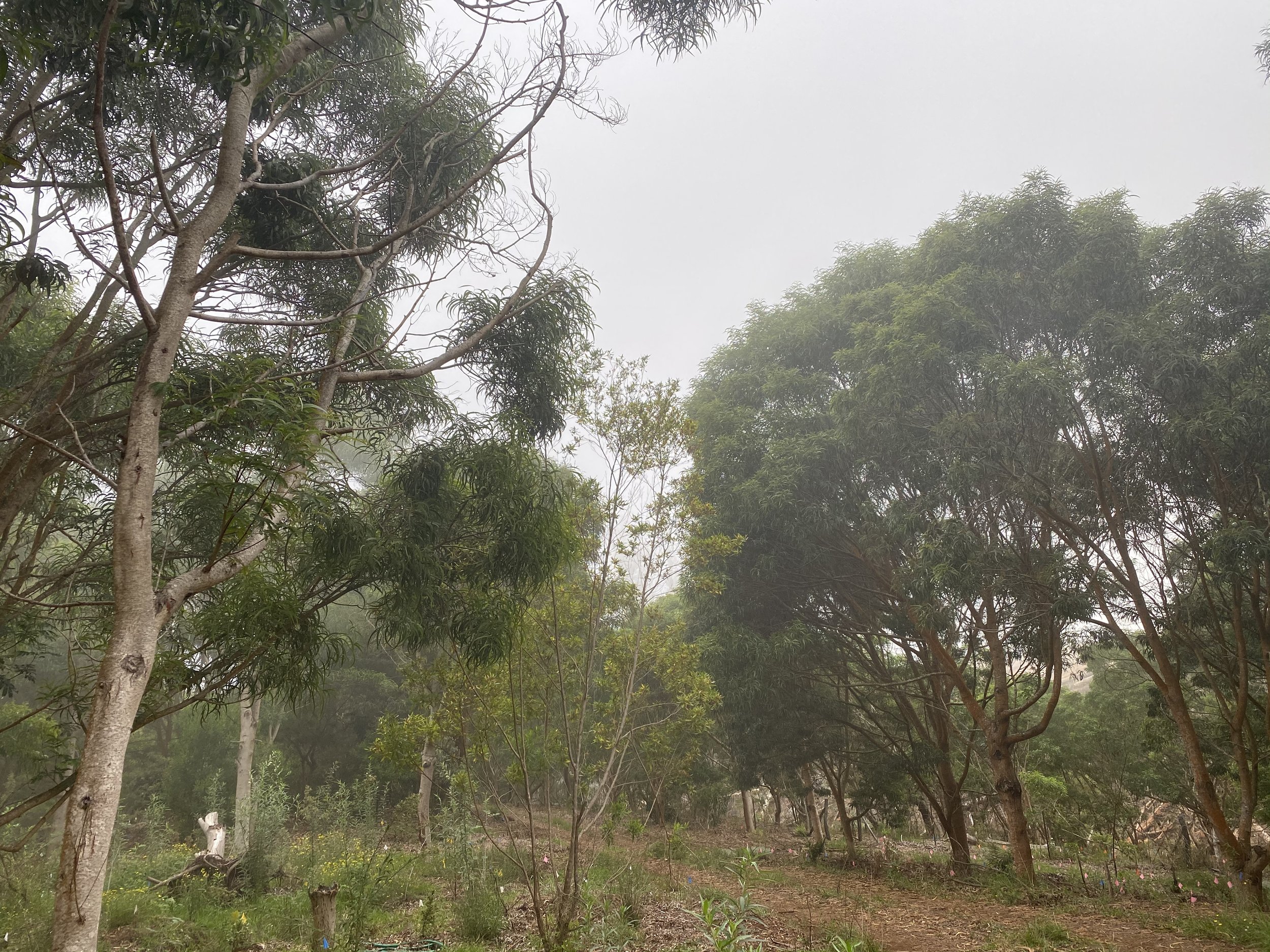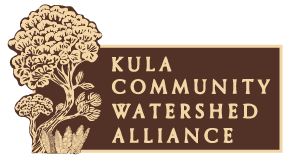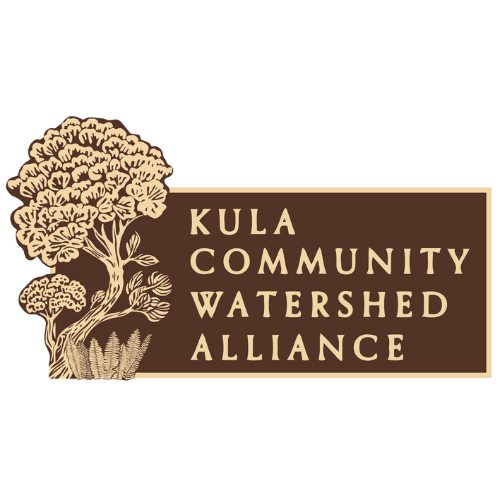
A healthy, resilient landscape
will rise from the ashes.
THE KULA FIRE RESTORATION PROJECT
The Kula Fire Restoration Project is a survivor-led effort to stabilize, protect, restore, and maintain the areas of Kula impacted in the August 2023 wildfire.
-
Since September 2023, KCWA has been actively leading the outreach, planning, and community engagement efforts required to conduct an intentional, expert-guided landscape scale ecological restoration project across 71 private properties and touching 200 acres of fire-damaged watershed. We have engaged hundreds of Maui residents in these efforts, including (but not limited to) hundreds of volunteers, Hawai’i Land Trust Ahupua’a Stewards interns, UH Maui College Sustainable Science Management students, and the fire-affected communities of Kula. To date, we have successfully raised $1.6 million in public and private funding that has been earmarked for this inclusive, multi-year restoration effort.
Thanks to generous donors, starting in Fall 2023, we have:
Partnered with Nā Koa Manu Conservation, whose board of directors adopted KCWA has one of their sponsored projects;
Formed a Neighborhood Council of Kula’s fire survivors who have volunteered their time to guide and assist the work of the Alliance;
Conducted a comprehensive survey of the entire burn scar, inclusive of 71 properties;
Stabilized, fenced, and planted a 600 square meter test plot to test and demonstrate our four-step restoration process;
Removed 21 acres of Eucalyptus and Wattle trees (dangerous fire fuels, both felled and burned in the storm) from the immediate fire-stricken area;
Stabilized 8 acres of burned land with a 3” blanket of Wattle and Eucalyptus wood chips, successfully stabilizing at-risk areas prior to the Winter 2023-24 rainy season;
Removed 40 acres of invasive species that regrew in the burn scar after Winter 2023-24;
Created good paying jobs for 17 Maui residents engaged in the management and execution of KCWA’s restoration plans (with many more to come);
Collected tens of thousands of restoration-appropriate native seeds from trees that evolved in our ecological region;
Partnered with Hawai’i Agricultural Research Center, who will provide our restoration efforts with an abundance of Fusarium-resistant koa saplings to prevent die off;
Partnered with 6 different community nurseries to help us propagate seeds (while we build our own nursery);
Became a part of the academic curriculum for the University of Hawai’i Maui College Sustainable Science Management bachelor’s degree program;
Presented about our community-led efforts at two major conferences: the Hawai’i Conservation Conference in Honolulu and the After the Flames conference in Estes Park, Co, as well as several community associations, rotary clubs, and County-sponsored meetings;
Served (and continue to serve) as Kula community representative and Natural and Cultural Resources Lead with the the County of Maui Office of Recovery’s Long Term Recovery Group;
Hosted site visits with a wide variety of public officials and dignitaries, including members of the Biden Administration’s Cabinet, lead Administrators at FEMA, and our Congressional Delegation;
As Co-Principal Investigator in a National Science Foundation-funded CIVIC Innovations grant, KCWA was selected for a research grant that examines community-led post-fire restoration and fire mitigation strategies;
Hosted over 40 open-to-the-public community meetings that include the community in decision making and offer access to experts, guests speakers, and our restoration partners at the Maui Emergency Management Agency, FEMA, NRCS, US Forest Service, DOFAW, Hawai’i Wildfire Management Agency, Pacific Fire Exchange, Keālia Pond National Wildlife Refuge, Skyline Conservation Initiative, Nā Koa Manu Conservation, UH Mānoa, Hawai’i Agricultural Research Center, and more; and
Partnered with Skyline Hawaiʻi to serve as a training site for its conservation crew, building ungulate proof fence to protect our 600 square meter “teaching gardenʻ in time for planting at Makahiki.
Planted out our 600 square meter “teaching garden” in the burn zone and began a monitoring process to track watershed health improvements
Organized and hosted two field trips with leaders working in wildfire resilience throughout the state as part of the National Science Foundation Civic Innovations grant we were awarded alongside UH Mānoa
Supported landowners with long-term stewardship planning and resource access across 350 acres in the immediate Kula Fire area to ensure long-term maintenance of restoration areas
-
Coming up in Fall 2024 and into 2025:
Building our Community Restoration Nursery and Tool Library, growing the first round of native plants for landscape scale restoration in the burn zone;
Assisting with community outreach as the NRCS Emergency Watershed Protection Program begins work that touches 90 properties, removing fire fuels throughout the burn area and stabilizing the burned land with mulch;
Working with all 71 individual landowners and an invasive animal-proof fencing expert on a strategy to protect the restoration areas in the burn scar;
Engaging hundreds of volunteers, including Upcountry school children and families, in ecological restoration for resilience through the replanting of over 110 acres of fire-stricken land.
Learn more about our restoration process, which is guided by a group of subject matter experts, below. Fire-affected landowners can sign up to receive KCWA-funded restoration support here.
-
Our first step is to safely set a healthy foundation to build from. We are beginning with a fire-scorched disturbed landscape–the fireʻs intensity combined with soil dehydration prior to the fire has left us with completely sterile soil without structure or organic matter.
In order to repair the soil safely, we are applying a mulch treatment made of invasive woody material collected nearby. The much provides a protective blanket over the soil, stabilizing it, slowing water down along the slopes, filtering rainwater and nutrients into the soil below, and getting it ready for planting.
-
The restoration of this fire-effected area comes with many challenges, not the least of which is invasive species–both flora and fauna. The lands in our area were disturbed by deforestation and invasive, fire prone plant species well before the fires. Our area is also known for a large Axis Deer population, which is devastating watersheds all over Maui County. As an Alliance, we are committed to prioritizing landscape resilience Kula in the face o. these challenges.
This is why weʻll need to engage in what‘s called in “Assisted Natural Regeneration,” meaning that human efforts will need to support the process along the way. We will do everything we can to reduce fire fuels, prevent invasive species regrowth, and to keep Axis Deer away from our restoration site. This will be achieved through a variety of methods, including systematic weed control and fencing where appropriate.
-
With the guidance of ecological and cultural advisors, we will restore a healthy watershed environment using site-appropriate native plants and trees planted in the burned areas to return native groundcovers to the understory, shrubs to the mid-story, and magestic trees to the canopy.
This area of Kula, known as Pōhakuokalā (and Pūlehu just downhill), is home to a montane mesic forest known to biologists as a former home to a tremendous amount of biodiversity. As much as possible, we strive to restore the ecological identity of this area through careful sourcing of seeds within our ahu’pua’a and nearby habitat preserves and saplings that have origins nearby. Several partner organizations have already begun growing these for us.
-
Stewardship is a marathon, not a sprint. We are committed to assisting participating landowners with tools and funds for long-term maintenance of restoration areas, and this will include careful monitoring, weeding, fence repair, and plant care.
Community work days to maintain our watershed (in the safest areas of the restoration zone) will be a big part of our maintenance plan.
Sign up for our mailing list to be informed of upcoming volunteer opportunities.
Explore all the ways to join us and get involved.
Join the Alliance.
Are you a concerned resident living in the fire affected areas of Kula? A potential partner that can bring resources to our effort? Join the Kula Community Watershed Alliance and connect with like-minded neighbors who are dedicated to restoring the lands they call home.
Make a Gift
Post-fire recovery, soil stabilization, and land restoration of this magnitude is a long-term stewardship process that requires hard work, specialized equipment, expertise, and resources to properly execute. Please give what you can to help us make our neighborhood fire-safe, recover the land, and support its vitality.
Watch the Watershed.
Have you noticed anything new in your watershed? Submit your observations to our crowdsourced citizen science project to get to know our watershed better.
Volunteer
The Alliance is currently engaged in large-scale soil stabilization work in the burn areas requiring skilled contractors and machine operators – it is work that’s not quite suitable for volunteers.
Sign up to Join the Alliance, and choose the volunteer option, and weʻll be in touch when the opportunity arises!






